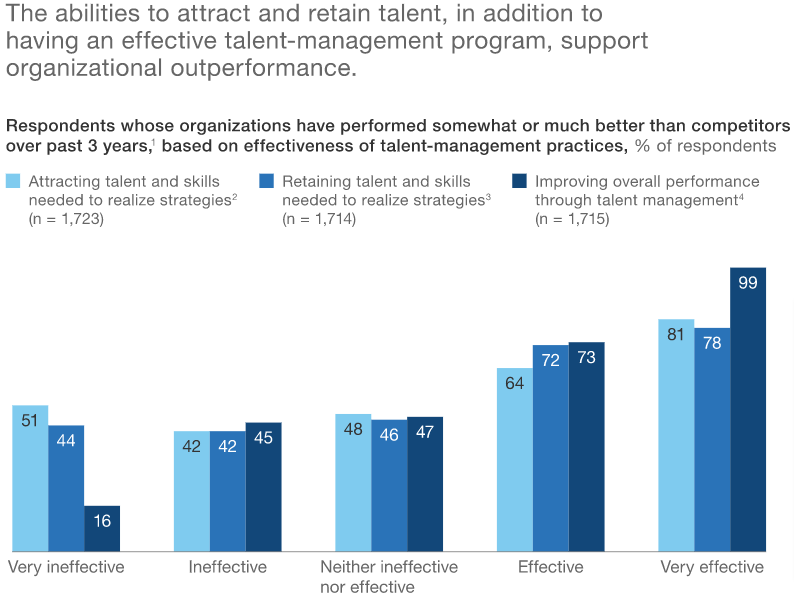It’s time to take the skill gap dilemma and turn it on its head. By implementing a talent development strategy, you can build a competitive edge that reduces risk, and can help put you ahead of the game. Talent development aims to build an organization that is high-performing, sustainable, and achieves its strategic and operational goals. Organizational talent development refers to a set of integrated HR processes for attracting, developing, motivating, and retaining productive, engaged employees.
Investing in your top talent is more like hitting ten birds with one stone when you consider all the benefits – as you’ll soon learn below.
What Is Talent Development?
Talent development is the process that identifies and develops an organization’s high potential employees. This could be a newly hired mid-level manager who is obviously headed for great things, or a long-time production line worker who is finally recognized as a vital part of operations.
Choose the Right Participants
The first step in creating a talent development program is to identify potential leaders and rising stars in the organization. What might seem like common sense has actually not been the historic way: The reality is that ‘fixed mindset’ companies tend to fill skill gaps by hiring from outside the firm. Instead, organizations need to adopt a ‘growth mindset’, which ties in with all kinds of other advantages related to talent development (see below).
Identifying potential talents is no easy task, either. Each organization has its own unique culture, and if you want to keep it in the long-term, it’s crucial to find potential talents who will keep that culture alive. While plenty of employees show the classic ‘boss’ hallmarks: Climbing the career ladder with charisma and always on the lookout for the next opportunity, that doesn’t necessarily translate into the ideal leader. An important factor is looking for the human who will drive performance and motivation and be a true team leader. Being able to communicate well, have empathy, and be a team player should not be overlooked in your search.
You’ll need to set clear criteria for selection, using both objective and subjective data to equate the employee’s potential. From the employee’s autonomy to interpersonal relationships, how they build professional relationships to if they’re already seen by their peers as a ‘leader,’ creating these criteria can help choose the best person or people for talent development.
Determine the Skills Your Chosen Participants Should Develop
After identifying the talent you aim to develop, your next step is determining the unique leadership skills they’ll need to grow. One approach is to ask the employee how they see themselves developing along with their manager, and meeting with leadership to match the skills needed to grow with the business strategy. Keeping an eye on which L&D skills your industry is emphasizing can also help. L&D pros should also set skill KPIs for the program candidates and check what each are lacking, adding those to their personal talent development programs.
Many talent development programs fail because there’s a lack of collaboration between HR and leadership, which can lead to less-than-optimal results including hiring from the outside. But even those outside hires will need onboarding and development, so it’s not a great outcome. Make sure you’re working with your leadership to understand their long-term goals and ensure they understand how your talent development strategy fits into it.
Find and Select the Coach or Mentor Best Suited for the Job
Once skills have been identified, it’s time to choose an expert to teach them. Finding the right program or leadership coach to work with is a challenge; “needle in a haystack” isn’t really an exaggeration when you consider the thousands of mentors and coaches of all levels of effectiveness. The person must have proven expertise in exactly the skill in question; have a personal ‘click’ with the employee; and be available according to the schedule of the client.
The optimal method to implement talent development programs is by offering one-on-one, customized courses. Each candidate has a unique range of skill requirements, and they can’t be efficiently acquired in a group setting. This may demand more resources, but why take the risk of squandering the chance to adequately train your best people? The wrong type of program not only wastes L&D resources, it also wastes employee and company time – all with next-to-no impact. One-on-one development is now scalable, creating the perfect opportunity for developing different talent pools for your various long-term needs.
Why Prioritizing Talent Development Is Essential to Business

Source: McKinsey
Connecting talent development to business objectives pays off in so many ways. According to McKinsey, companies that rapidly assign high performers to critical strategic areas were 2.2 times more likely to outperform their slower competitors.
Ensuring a competitive strategy for top talent retention reduces turnover. There are many reasons why employees quit, and one of them is a lack of personal development opportunities, as cited by 80% of Millennials and Gen-Z’s.
Future-proofing your organization, and enabling succession planning, benefits from building talent. In the third quarter of 2020, 30 million Baby Boomers retired; this trend is seen by some as a pending crisis. As leaders retire or leave, it’s essential to have a succession plan and the needed L&D programs in place to easily fill those positions with current employees.
Recruitment improves when talented job seekers realize the opportunity for professional development in a firm with related programs. According to this McKinsey study, companies with effective talent management practices show superior performance when it comes to attracting the skills required for the implementation of strategy.
3 Ways to Improve Talent Development at Your Organization
Whether you are about to implement a new program, or want to optimize one that is currently running, these are some tips for getting the most out of your talented workers:
- Invite employees at all levels to get involved in the talent development program. Motivate executives to advocate and get organizational cooperation for the program; ensure that mid-level managers support the initiative; and promote the program to employees as a means for both personal and professional development.
- Focus more on soft skills, including communication and collaboration, to develop a more empathetic, collaborative workplace. This fits with a growth mindset, characterized by inclusivity and the encouragement of individual initiative.
- Establish a culture that rewards continuous skill development and fosters the value of perpetual learning. This again is a characteristic of growth mindset companies, where the attainment of additional skills is limited only by lack of opportunity.
Where Talent Development Meets Technology
GrowthSpace uses an AI-based L&D platform that answers critical needs for any organization in search of a high performance talent development program. Its technology enables smart matching between coaches and mentors with proven expertise in teaching the exact skills in question. GrowthSpace also specializes in sprint-based L&D programs that get employee skills up to grade in minimum time. Talk to the talent at GrowthSpace today to get on the right training track.




